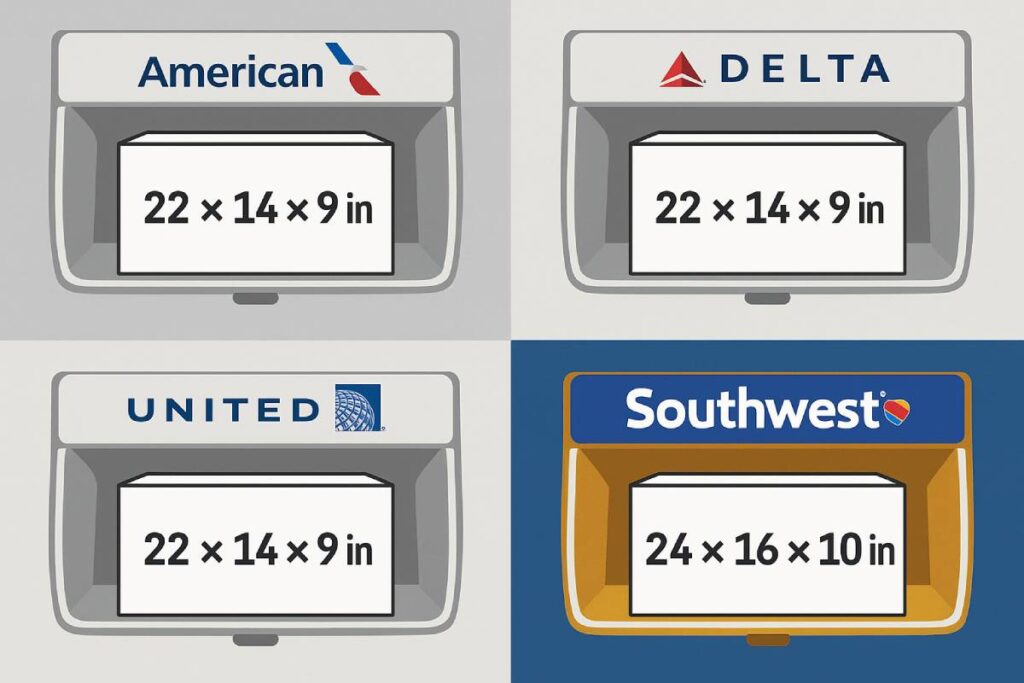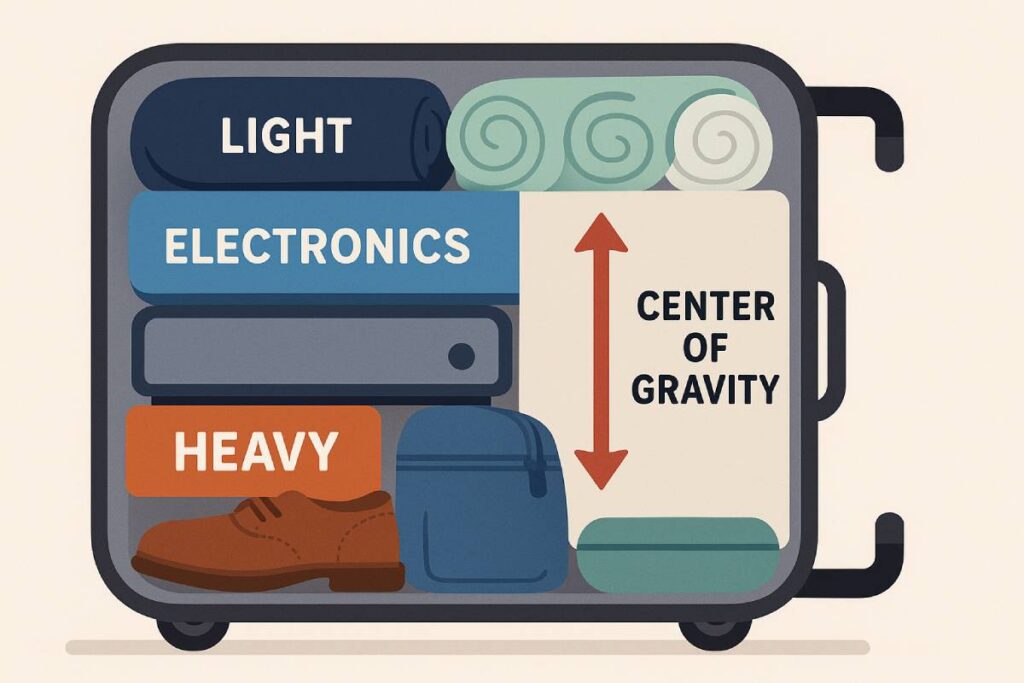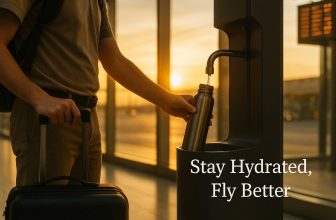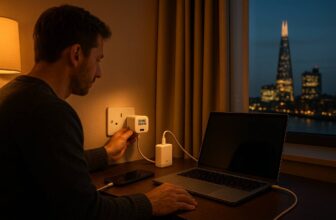Imagine gliding through the airport without ever waiting at baggage claim—71% of travelers are now doing just that by skipping checked bags and relying only on carry-ons.
With airlines tightening size limits and slapping on hefty fees, packing smart is no longer optional—it’s essential.
In this guide, we’ll walk you through mastering airline carry-on restrictions, choosing between rolling and folding, wielding packing cubes and multi-purpose gear, and perfecting weight distribution to fit more without overpacking—all backed by real-world tests and expert insights.
Compare Airline Carry-On Size Limits
Most airlines worldwide follow the IATA guideline of 56 × 45 × 25 cm (22 × 18 × 10 inches) for cabin baggage, but individual carriers set their own rules on top of this recommendation.

In the U.S., American, Delta, and United all allow one carry-on bag up to 22 × 14 × 9 inches (56 × 36 × 23 cm) plus a personal item. Southwest Airlines offers a slightly larger free carry-on allowance—24 × 16 × 10 inches (61 × 41 × 25 cm)—and still includes one personal item under the seat.
Across the pond, British Airways permits a 56 × 45 × 25 cm bag plus a small item (40 × 30 × 15 cm) with a combined weight of up to 23 kg, while Emirates caps cabin baggage at 55 × 38 × 22 cm with a 7 kg limit in Economy (10 kg in Premium Economy), and additional briefcase allowances in Business/First.
Major U.S. Carriers
| Airline | Max Dimensions (inches) | Max Dimensions (cm) |
|---|---|---|
| American | 22 × 14 × 9 | 56 × 36 × 23 |
| Delta | 22 × 14 × 9 | 56 × 35 × 23 |
| United | 22 × 14 × 9 | 56 × 35 × 23 |
Note: Handles and wheels are included in these measurements, and bags must fit in overhead bins.
Southwest Variation: Southwest allows one carry-on bag up to 24 × 16 × 10 inches (61 × 41 × 25 cm), including all attachments, plus a personal item under the seat.
International Carriers
- British Airways: One piece of hand luggage up to 56 × 45 × 25 cm and one small item (40 × 30 × 15 cm); combined weight up to 23 kg.
- Emirates:
- Economy Class: 55 × 38 × 22 cm, 7 kg max
- Premium Economy: 55 × 38 × 22 cm, 10 kg max
- Business & First Class: One briefcase up to 45 × 35 × 20 cm plus one handbag up to 55 × 38 × 22 cm (or one garment bag ≤ 20 cm thick), each item ≤ 7 kg.
Understanding these limits ensures you pack smart, avoid gate-check fees, and breeze through boarding.
Rolling vs. Folding Techniques
Tight rolling minimizes air gaps, letting you pack up to nearly twice the volume compared to loose folding by creating dense, sausage-like bundles. Folding excels for structured garments—like blazers or dress shirts—by keeping crisp lines and preventing deep creases.
Below, you’ll find the key benefits of each method and a custom infographic illustrating exactly how much space you save when you roll instead of fold.
Benefits of Rolling
- Air-Gap Reduction: Rolling each garment into a tight spiral removes dead air pockets. As one Reddit study noted, the primary space savings come not from compressing the fabric but from minimizing gaps between rolls.
- Volume Gain: Frequent travelers report fitting almost twice as many items when rolling vs. folding—one OneBag user observed nearly a 100% packing boost using rolls plus packing cubes.
- Wrinkle Resistance: With fewer creases, rolled cotton, linen, and knit garments emerge ready to wear—Trafalgar Tours even dubs rolling a “space-saving superpower” that also reduces wrinkles.
- Tetris-Style Packing: Cylindrical bundles slide into irregular gaps and corners, giving you the flexibility to use every inch of your bag without leaving wasted pockets of space.
Benefits of Folding
- Structured Garment Care: Folding is ideal for items with internal structure—blazers, dress shirts, or trousers—where precise folds maintain shape and prevent deep wrinkles.
- Quick Access: Flat stacks let you see and remove specific pieces without disturbing the rest of your packing layout, which is perfect for business travelers needing that crisp blazer on day one.
- Hybrid Strategy: For best results, roll casual, wrinkle-resistant fabrics and fold formal or heavy items, then layer them together—this hybrid approach balances space savings with garment protection.
Visual Aids
Below is a custom-designed infographic comparing rolled vs. folded stacks in the same carry-on compartment—notice how the rolled side fits more dense bundles with virtually no gaps, while the folded side shows clear air pockets and wasted volume.
By understanding these techniques, you can optimize both space and garment care. Next up: packing cubes, compression bags, and strategic layering to push your carry-on capacity even further!
Packing Cubes and Compression Bags
Packing cubes and compression bags revolutionize how you organize and maximize carry-on space. By compartmentalizing items into dedicated cubes, you eliminate the “jumbled mess” effect and keep outfits, undergarments, and accessories neatly separated.
Compression variants add a second zipper that squeezes out air, shrinking cubes by 1–2 inches per side and freeing up to 20% more volume per cube. Durable, mesh-windowed designs make contents visible at a glance, while strong zippers and handles stand up to repeated use.
Below, learn exactly how packing cubes work, which top picks travel experts recommend, and an organizational layout to streamline every trip.
How Packing Cubes Work
Packing cubes are small, zippered pouches that let you group like items—shirts, pants, sleepwear—into self-contained modules. Their structured walls prevent garments from shifting, so clothes emerge wrinkle-free whether you roll or fold them.
Compression cubes add a second zipper that, when closed, forces air out of the pouch, pulling its fabric walls inward for a tighter bundle. Mesh panels or clear windows maintain breathability and visibility, so you can spot what’s inside without unleashing the contents.
This compartmentalization not only boosts packing efficiency but also speeds up security checks—agents can often see through cubes without unpacking them.
Top Compression Cube Picks
| Brand & Model | Key Features | Price (per cube) | Source |
|---|---|---|---|
| Calpak Large Compression Cubes | Fit up to 26 items; dual-zipper design for max squeeze; sturdy polyester build | $26 | instyle.com |
| Bagail 8-Piece Packing Cube Set | Includes medium, large, XL, cosmetics & undergarment bags; mesh panels for visibility | ~$15 | people.com |
- Calpak Large Compression Cubes: InStyle’s real-world test proved these cubes pack 26 garments wrinkle-free into a single carry-on, thanks to adjustable zippers that tighten bundles on demand.
- Bagail 8-Piece Set: Highlighted by People for summer travel, this budget-friendly pick includes dedicated pouches for socks, underwear, and toiletries—ideal for month-long vacations when you need both variety and visibility.
Organizational Layout
Use a mix of cube sizes to build a capsule packing strategy. The table below shows the recommended dimensions and contents:
| Cube Size | Approx. Dimensions (L×W×H) | Ideal Contents |
|---|---|---|
| Large | 15 × 11 × 4 inches | 4–6 tops (T-shirts, blouses) |
| Medium | 13 × 9 × 4 inches | 2–3 bottoms (jeans, shorts) |
| Small | 11 × 6 × 3 inches | Underwear, socks, swimwear |
| Slim/XL | 17 × 12 × 3 inches | Jackets, blazers, bulkier items |
Start by filling the large cube with rolled T-shirts for maximum density. The medium cube holds folded pants or skirts, while the small cube tucks undergarments and accessories into tight bundles.
A slim/XL cube is perfect for structured pieces—like a blazer—so you can fold along natural seams without causing bulges. Nest these cubes side by side or stack them vertically to fill every inch of your carry-on compartment.
By integrating packing cubes and compression bags into your routine, you’ll slice through boarding lines, breeze past baggage fees, and arrive organized—no matter the destination.
Multi-Purpose Item Recommendations
Multi-purpose travel items let you streamline your carry-on, cut bulk, and stay comfortable on the go. From zip-off pants and jackets that double as pillows to scarves that transform into neckrests and modular toiletry systems, these smart solutions maximize every inch of space and functionality.
Below, you’ll find expert picks with real-world performance and quick-reference tables to guide your next packing spree.
Convertible Clothing
Travel-ready garments that switch functions on demand:
- Zip-Off Pants → Shorts: Adventure-proof pants with hidden thigh-level zippers let you drop from full-length to shorts in seconds—perfect for hiking trails that transition from cool forests to sun-baked clearings. Clothing Arts’ Pick-Pocket Proof® Convertible Pants feature reinforced zippers sewn into soft nylon for comfort and security. Amazon’s best-selling Men’s Outdoor Quick-Dry Zip-Off Trousers ($29.99) earn 4.3★ from 390+ reviews for versatility and moisture-wicking performance amazon.com.
- Jacket → Pillow: Stay warm on chilly layovers, then stash your coat as a neck pillow once you’re airborne. The Weatherproof Pillow Pack Puffer Jacket tucks into its collar pouch, snapping into a cozy travel pillow for $150—an Editors’ Pick for multifunctional outerwear. Nomatic’s Outset Jacket similarly folds into its own pocket, doubling as a compact headrest on long-haul flights.
| Item | Functionality | Price |
|---|---|---|
| Pick-Pocket Proof® Convertible Pants | Pants ⇄ Shorts; hidden security zip | ~$85 |
| Zip-Off Quick-Dry Trousers | Pants ⇄ Shorts; lightweight fabric | $29.99 |
| Pillow Pack Puffer Jacket | Jacket ⇄ Neck Pillow | $150 |
| Nomatic Outset Jacket | Jacket ⇄ Pillow; integrated pocket | $199 |
Dual-Use Accessories
Accessories that pull double duty, cutting down on extras:
- Infinity Scarf → Travel Pillow: A soft, stretchable infinity scarf conceals a hidden foam pillow core—wrap it twice for warmth, then extend and stuff for lumbar or neck support. Condé Nast Traveler’s roundup of 2-in-1 travel gear highlights this scarf as both a style staple and space-saving sleep aid.
- Water Bottle + Hidden Cup: The Bottlecup 2-in-1 is an insulated stainless-steel bottle with a twist-out silicone cup in its base. Slip out the cup for caffeine or hydration, then stow it back seamlessly—no extra bulk.
| Accessory | Dual Functions | Price | Source |
|---|---|---|---|
| Infinity Scarf with Pillow Core | Scarf ⇄ Travel Pillow | ~$30 | cntraveler.com |
| Bottlecup 2-in-1 Reusable Bottle/Cup | Bottle ⇄ Silicone Cup | $35 | us.bottlecup.com |
Tech & Toiletry Gear
Compact solutions for electronics and grooming essentials:
- Collapsible Water Bottles: Fold down to pocket size when empty, then pop open for full hydration capacity. Que’s collapsible bottle is made of food-grade silicone, expands to 20 oz, and shrinks to a flat disk—zero wasted space. Travel + Leisure’s 2025 Buyers’ Guide lists the LifeStraw Peak Series ($44) and HydraPak Seeker ($28) as top performers for leak-proof design and durability.
- Modular Dopp Kits: Side by Side’s Travel Packer LT features detachable dopp cubes and customizable compartments, letting you bring only the products you need—no bulky, half-empty toiletry bags. InStyle’s three-week Italy packing test praised Cadence’s modular capsules, which fit nine beauty items compactly alongside clothes in a single carry-on. Reddit travelers also rave about modular kits that adapt for first-aid, cosmetics, or electronics, cutting weight and streamlining unpacking.
| Gear | Key Benefit | Price Range |
|---|---|---|
| Que Collapsible Silicone Bottle | Expands/collapses; BPA-free | $25–$30 |
| LifeStraw Peak Series Collapsible Bottle | Leak-proof; integrated filter; 17 oz | $44 |
| HydraPak Seeker Collapsible Container | 34 oz capacity; hard shell; leak-resistant | $28 |
| Travel Packer LT Modular Toiletry Bag | Detachable dopp cubes; customizable | $60–$80 |
| Cadence Modular Capsules (beauty & meds) | Custom capsule system; space-efficient | $52 (2 cubes) |
| Reddit-Approved Modular Travel Kit | Multi-purpose; adaptable compartments | Free–$50 |
By choosing multi-purpose travel items, you’ll shave ounces and inches off your carry-on, simplify your boarding process, and arrive organized and ready—no matter where your journey takes you.
Weight Distribution Techniques
Most travelers find that strategic weight placement transforms a wobbly, overstuffed carry-on into a stable, easy-rolling companion. By bottom-loading your heaviest items—think shoes and toiletry kits—right above the wheels, you lower the center of gravity and prevent tipping or unexpected spills.

Equally important is balanced packing: layer mid-weight items like electronics in the center and reserve the top for lighter, softer goods such as clothing.
This “bottom-heavy, top-light” approach keeps your bag upright, eases maneuvering through crowded terminals, and even reduces strain when lifting into overhead bins.
Bottom-Loading Heavier Items
- Stability & Maneuverability: Placing dense items (shoes, toiletry bags, small electronics) at the bottom near the wheels creates a low center of gravity, dramatically reducing the chance your bag will topple over when upright.
- Smooth Rolling: With weight concentrated over the wheelbase, rolling across uneven surfaces or through busy terminals becomes effortless, as the bag naturally tracks straight without pulling backward.
- Protection of Delicate Items: Lighter, fragile gear (sunglasses, chargers) rides above heavy items, shielding them from impact when the bag is set down or jostled.
- Hygiene & Organization: Shoes can carry dirt and germs; loading them in a separate compartment or bag at the bottom keeps clothes and accessories clean while maintaining order.
| Layer | Items | Benefit |
|---|---|---|
| Bottom | Shoes, toiletry kit, heavy books | Stability, smooth rolling |
| Middle (Core Balance) | Electronics, guidebooks, compact gear | Even weight distribution, protection |
| Top | Rolled clothes, scarves, soft items | Cushioning, quick access, lighter lift |
Handles and zippers count toward overall dimensions—always test-roll before you go.
Balanced Packing
- Layered Weight Zones: After bottom-loading, fill the core with mid-weight items—laptops, cameras, toiletry extras—to maintain even mass distribution.
- Top-Light Finish: Reserve the uppermost section for soft, lightweight essentials like rolled T-shirts, underwear, and scarves. This “top-light” zone prevents your bag from leaning forward when standing.
- Symmetrical Layout: Distribute items evenly from left to right. Avoid cramming all the weight on one side, which can lead to awkward pulls and accelerate wear on wheel bearings.
- Test & Adjust: Before departure, zip up and stand the bag upright. If it tilts, shift a small item from top to bottom or redistribute electronics until it stands perfectly vertical.
By mastering these weight distribution techniques, you’ll minimize gate-check requests, glide through security with ease, and keep your carry-on as balanced as a well-packed carry-on should be.
Essentials vs. Non-Essentials
A solid packing strategy starts with knowing what you truly need versus what’s nice to have and pairing that with a lean, mix-and-match wardrobe that maximizes outfit options without the extra bulk.
Below, you’ll find a detailed pre-trip checklist that separates must-have essentials from non-essentials—complete with a downloadable PDF link—and a proven capsule wardrobe approach to cut your garment count while still delivering endless outfit combinations.
Pre-Trip Checklist
A comprehensive pre-trip checklist categorizes items into must-haves—those you can’t travel without—and non-essentials that add comfort or convenience but aren’t strictly required.
Must-have items typically include travel documents, payment methods, medications, basic toiletries, and electronics chargers for smooth passage through security and a worry-free trip.
Non-essential items might include entertainment gear like e-books or portable games, extra accessories such as a travel pillow or noise-canceling headphones, and season-specific extras like a sunhat or compact umbrella.
| Category | Must-Have Items | Optional Items |
|---|---|---|
| Travel Docs & Paperwork | Passport/ID, visas, boarding passes, travel insurance info | Copies of itinerary, guidebook, emergency contacts |
| Financial | Credit/debit cards, local cash | RFID-blocking money belt or travel wallet |
| Health & Safety | Prescription meds, basic first-aid kit, hand sanitizer | Insect repellent, travel steamer, compact UV sanitizer |
| Toiletries | Toothbrush, toothpaste, deodorant, travel-size shampoo/soap | Hairstyling tools, full-size fragrances, extensive makeup kit |
| Tech & Electronics | Phone, chargers, power bank, universal adapter | Tablet/e-reader, portable speaker, camera accessories |
Capsule Wardrobe Strategy
A well-planned capsule wardrobe pares down your garments to versatile, interchangeable pieces, reducing your total clothing count by up to 67% while still delivering dozens of outfit combinations. Start by selecting a cohesive color palette of 3–4 neutral shades, then add 2–3 accent pieces to inject variety and personality.
Choose fabrics that layer well—lightweight knits, breathable cotton, and wrinkle-resistant blends—to handle different climates and activities without bulk. Stick to essential silhouettes: two bottoms, three tops, one blazer or jacket, and one multipurpose dress or jumpsuit to easily mix and match throughout your trip. Use the “1-to-6 rule,” where each piece should pair with at least six others, ensuring every item earns its place in your suitcase.
- Limit to 10–12 Core Pieces: A 12-piece wardrobe can create over 30 outfits via layering and accessories.
- Choose Dual-Purpose Pieces: A single blazer that works for both business meetings and evening dinners cuts down on bulk.
- Test Combos Ahead of Time: Lay your selected items on the bed to confirm every top pair with all bottoms.
- Prioritize Quick-Dry, Wrinkle-Resistant Fabrics: Materials like modal, merino wool, and high-performance blends stay fresh longer and need minimal ironing.
By distinguishing true essentials from nice-to-haves and embracing a capsule wardrobe mindset, you’ll pack lighter, move faster through airports, and still have all the outfits you need—no suitcase slam required.
Quick Actionable Tips & Real-World Examples
Applying lightweight, high-impact tweaks can instantly transform your carry-on from overstuffed to streamlined, saving both space and stress. Weighing each item and trimming the heaviest 20% before you pack slashes needless bulk and sets you up for efficient loading.
Packing your largest, bulkiest pieces first—akin to putting “rocks” in a jar—then filling gaps with smaller “pebbles” and “sand” can boost usable space by up to 20%.
Finally, embracing a minimalist “5-4-3-2-1” capsule strategy pares your wardrobe to essentials (five tops, four bottoms, etc.) while enabling dozens of outfits, cutting garment count by over 60%.
Before/After Photos
See the dramatic difference between a typical, loosely packed carry-on and one optimized with these techniques:
Bullet-Point Cheatsheet
- Weigh & Pare: Weigh every item and remove or replace the heaviest 20% to immediately reduce load.
- Pack Rocks, Then Pebbles: Place your bulkiest gear (shoes, jackets) first, then tuck smaller items around them for maximum fill.
- 5-4-3-2-1 Method: Limit to 5 tops, 4 bottoms, 3 pairs of shoes, 2 outer layers, and 1 accessory set for a balanced, minimalist pack.
- Roll, Don’t Fold: Roll garments tightly—this can fit nearly twice as many items by eliminating air gaps.
- Use Packing Cubes: Compartmentalize and compress with dual-zip cubes to free up to 20% more volume per cube.
- Bottom-Heavy Loading: Stow dense items at the wheels’ base to lower your bag’s center of gravity for smooth, stable rolling.
- Selective Vacuum Bags: Seal bulky fabrics only when weight allows—vacuum bags save space but add their own weight.
- Wear Bulkiest Gear: Travel in your heaviest shoes and coat to save precious inches in your carry-on.
- Test & Tweak: Zip up and stand your packed carry-on upright—if it leans, shift a small item until it stands vertical.
- Go Digital: Swap paper guidebooks and maps for apps and e-readers to shed ounces and free space.
conclusion
With modern airlines charging for checked bags and overhead bins becoming ever more crowded, mastering carry-on optimization is no longer a nice-to-have—it’s an essential travel skill. By first understanding each carrier’s size limits, you avoid surprise gate checks and fees.
Then, choosing when to roll versus fold ensures you maximize every cubic inch while keeping your clothes wrinkle-free. Packing cubes and compression bags take the organization to the next level, squeezing out air and separating outfits for effortless retrieval. Multi-purpose garments and accessories—zip-off pants, jacket-pillow hybrids, convertible scarves—mean you wear your bulkiest items and leave less behind.
Strategic weight distribution, with heavy gear, bottom-loaded near your wheels and lighter pieces on top, keeps your bag stable and easy to maneuver. Finally, distinguishing true essentials from “nice-to-haves” via a pre-trip checklist and a capsule-wardrobe mindset slashes your total garment count without sacrificing style.
Armed with these techniques—and armed with your free packing checklist—you’ll breeze through security, board with confidence, and arrive organized, no matter the destination. Safe travels and happy packing!
FAQs
What’s the best way to meet strict airline carry-on size limits?
Measure your bag—including wheels and handles—against your airline’s published dimensions and choose soft-sided luggage to flex into overhead bins when needed.
Do packing cubes really save space?
Yes—compression packing cubes can reduce bundle volume by up to 20% by forcing air out with a dual-zip system, making room for extra items.
Should I roll or fold my clothes?
Roll casual, wrinkle-resistant fabrics to eliminate air gaps and fold structured pieces like blazers to maintain shape and prevent deep creases.
How can I avoid my carry-on tipping over?
Place dense items (shoes, toiletries) at the bottom near the wheels, then layer mid-weight items evenly in the center and lighter garments on top.
What’s a capsule wardrobe and why use it?
A capsule wardrobe is a small set of versatile pieces—10–12 total—that pair together in dozens of combinations, cutting your clothing count by over 60%.





